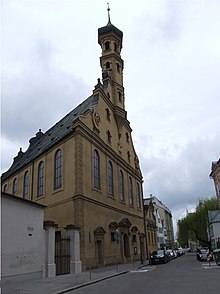Evangelical Holy Cross Church (Augsburg)
The Evangelical Lutheran Holy Cross Church in Augsburg was created in the 16th century from the expansion of a former chapel. After the demolition of this church in 1630, the church was rebuilt from 1652 to 1653. It is the first Protestant church in the city. As an architectural monument, it is entered in the Bavarian list of monuments.
history
In 1210 a cemetery chapel was built on the monastery grounds of the Holy Cross Church . Originally it was called Katharinenkapelle. Later it served the population as a people's church in order to reserve the collegiate church primarily for the Augustinian canons . In 1445/50 the Ottmar Chapel was built in its place. On a trip to Rome in 1511, Martin Luther visited the Holy Cross Monastery .
In 1525, during the Reformation , the city council assigned the Ottmar Chapel to the newly established Protestant community as a preaching house. Regular Protestant Sunday services were held there. In 1561, the Augustinian canons renounced their previous rights, whereupon the Protestants had the chapel expanded. It was also renamed the Holy Cross Church. With the edict of restitution , the Protestants were driven out of their church again and the Holy Cross was demolished in 1630. Until 1653 the community no longer had its own church. With the Peace of Westphalia of 1648, the Protestants got back the area on which their church was located.
The pastor Thomas Hopfer was able to donate the Danish King Friedrich III. as well as the Swedish Queen Christina , who gave the community 5,000 guilders from her private fortune. The Kistler Johann Jakob Krauss built today's church building in 1652/53 with a striking three-storey facade and three portals in the style of a typical Protestant preaching church. The consecration took place on October 24, 1653. It is the first Protestant church building in Augsburg. After the secularization , the church served as a camp for Imperial Austrian prisoners of war from 1805. The French army locked around 1,200 Austrian prisoners of war there. A plaque unveiled in 2015 commemorates this event. From 1814 the church was used as a hay and straw store. In 1814 the Evangelical Holy Cross became a branch church of St. Anna and in 1840 it became an independent parish again.
The church survived the air raids on Augsburg in 1944, thanks to the intervention of the pastor Friedrich Westermayer and his deacon Oskar Irrgang; the adjacent Catholic Heiligkreuz church burned down.
Since 1955 the parish has had two parish offices. From 1979 to 1981 the church underwent a major renovation , the first in more than three centuries. In 1992 a new Rensch organ was purchased. In 2003 the parish celebrated the anniversary of the parish fair 3 50 years of Evang.-Luth. Holy Cross Church - a European Church of Peace.
architecture
The church has an idiosyncratic "crooked" and asymmetrical trapezoidal floor plan. It has a three-storey, volute-decorated gable facade with three portals and a dominating gable turret. The hall-like interior is provided with galleries, a freely hanging painted wooden coffered ceiling and a west-facing choir.
Furnishing
The fresco in the altar house was created by Johann Georg Bergmüller around 1730. The pulpit was made by Ignaz Wilhelm Verhelst based on a design by Johann Esaias Nilsons in 1762. The gallery balustrades with grisaille work came from Matthäus Gundelach . Jacopo Tintoretto painted the painting The Baptism of Jesus in 1570 and Johann Heinrich Schönfeld painted the paintings Christ Carrying the Cross and Christ Descent from the Cross in 1660 . The Resurrection of Christ by Johann Mayr was written in 1673. In 1674 Johann Spillenberger painted the Pentecost sermon of the apostles . The paintings The Last Supper by Josef Werner and The Dove of Christ by Johann Heiss date from the same year . The painting Faith, Love, Hope by Johann Georg Bergmüller followed in 1730 .
organ
Today's organ was built by organ builder Richard Rensch in 1992. The organ has 35 registers, which are distributed over 3 manuals and pedal. Your disposition is:
|
|
|
|
|||||||||||||||||||||||||||||||||||||||||||||||||||||||||||||||||||||||||||||||||
- Pair : I-II, III-II, IP, II-P, III-P
- Playing aids : Pleno moves for Hauptwerk, Positiv, Echo and Pedal
See also
literature
- Adolf Schott: The Protestant Church of the Holy Cross , 1903
- Horst Jesse: The history of the Evangelical Church in Augsburg . Ludwig Verlag, Pfaffenhofen 1983, ISBN 3-7787-2054-6 , p. 48 f., 243-246, 421 f .
- Detlef von Dobschütz (Ed.): The Protestant Holy Cross Church in Augsburg . Evangelical Luth. Parish office Heilig Kreuz, Augsburg 1981, DNB 870166174 .
- 350 years of Evang.-Luth. Holy Cross Augsburg , 2003.
- Helmut Rößle: Houses of God in the Bomb War - The Destruction of Augsburg Churches in the Second World War . Regio-Akademica-Verlag, Augsburg 2004, ISBN 3-938330-00-7 , p. 64 .
Web links
- Holy Cross Church in Augsburg. Evangelical Lutheran Church Community of the Holy Cross.
- Wilhelm Liebhart, Günther Grünsteudel: Holy Cross. In: Augsburger Stadtlexikon . .
- Holy Cross Church, Augsburg. (Building history).
Individual evidence
Coordinates: 48 ° 22 '18.4 " N , 10 ° 53' 28.9" E


